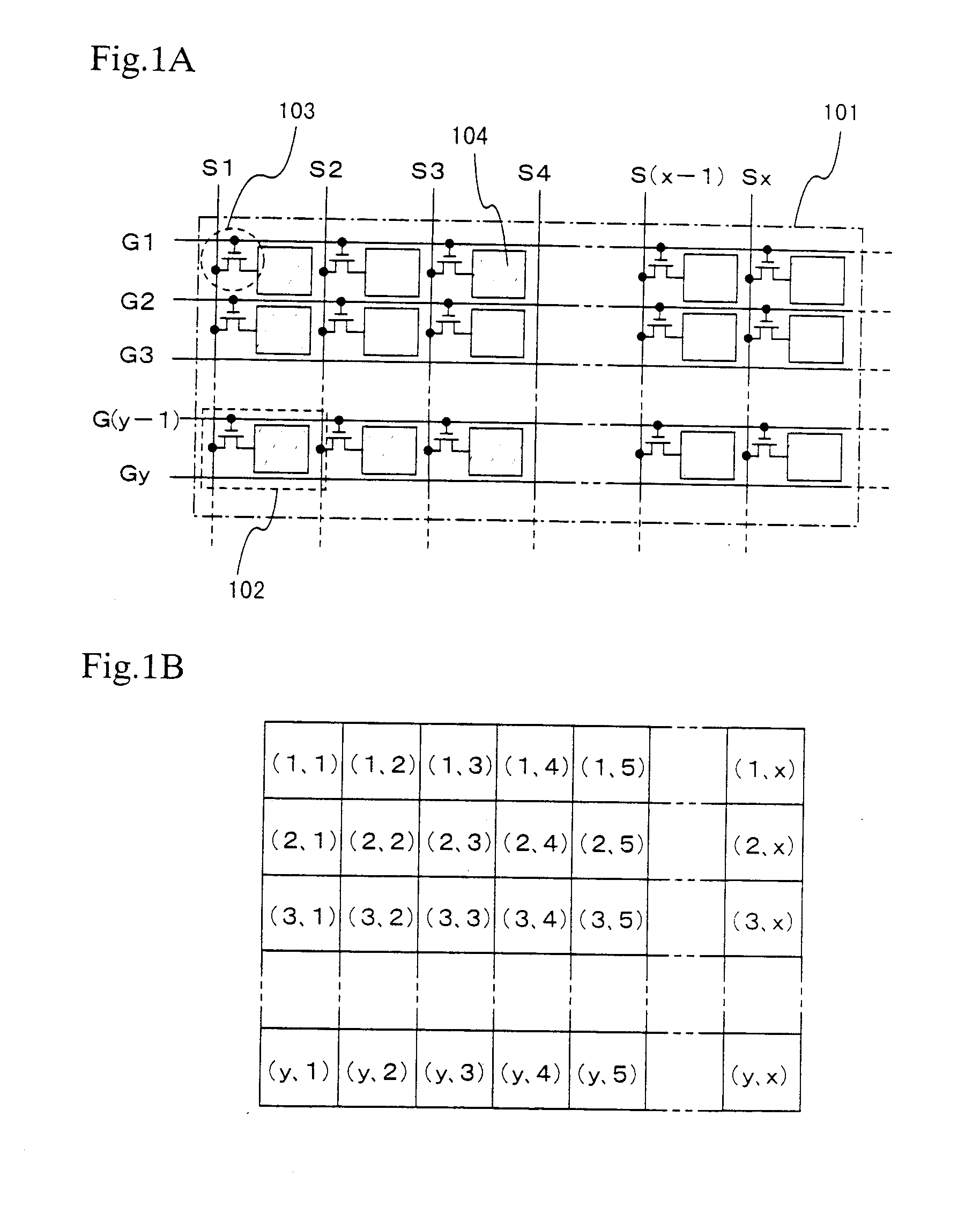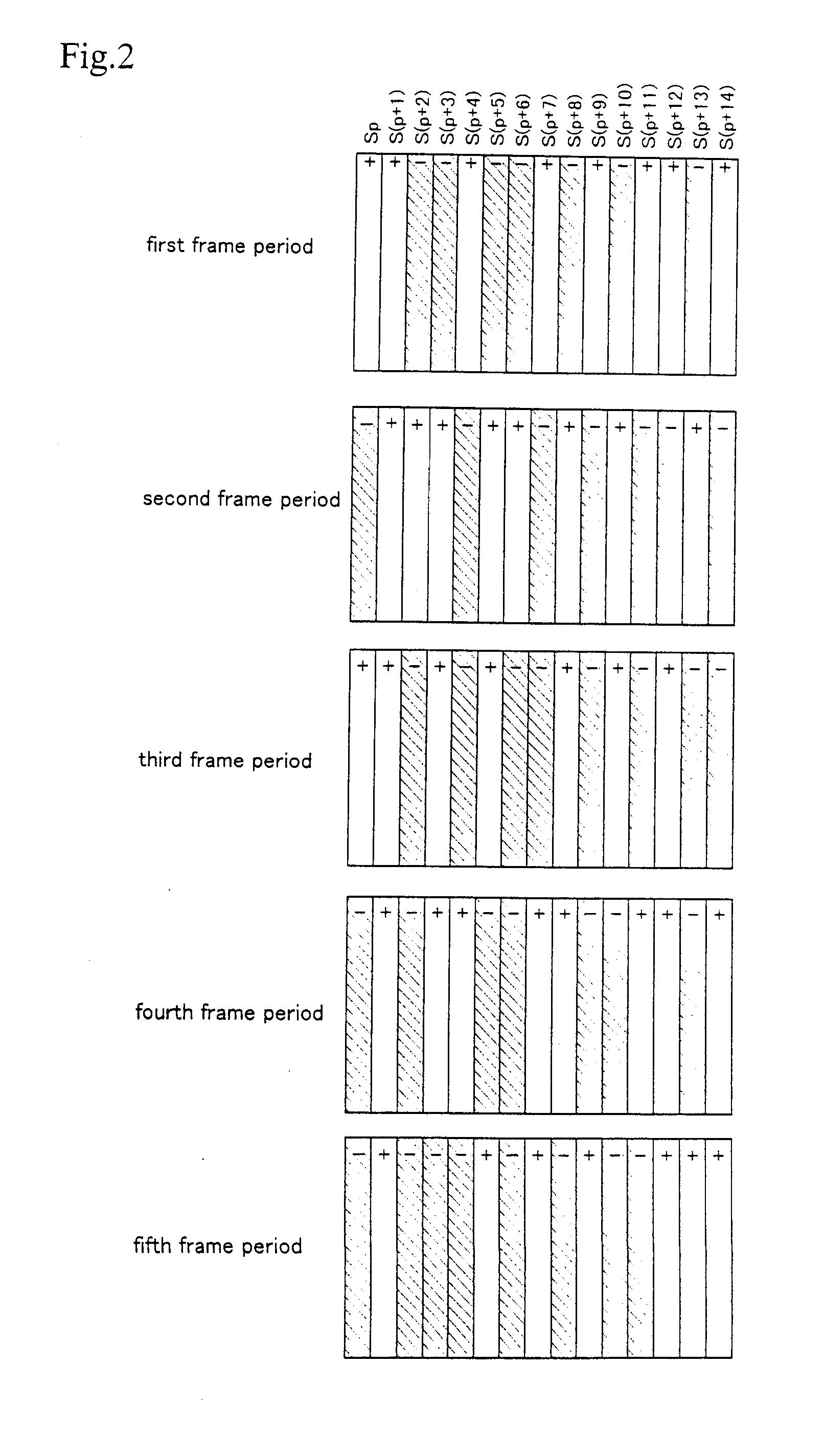Semiconductor device and method of driving semiconductor device
a semiconductor device and semiconductor technology, applied in semiconductor devices, instruments, electrical devices, etc., can solve the problems of flicker, difficult observation of horizontal striping, and difficulty in vertical striping and horizontal striping
- Summary
- Abstract
- Description
- Claims
- Application Information
AI Technical Summary
Benefits of technology
Problems solved by technology
Method used
Image
Examples
embodiment mode 1
[0203] A polarity pattern of each pixel in an alternating current drive of the present invention is shown in FIG. 2. Note that, in order to simplify the explanation, the polarity pattern of only pixels connected to 15 arbitrary adjacent source signal lines Sp, S(p+1), S(p+2), . . . , S(p+14) among the source signal lines S1 to Sx, is shown. Further, the pixels connected to each source signal line are not separated but are shown as one rectangle in Embodiment mode 1. Further, FIG. 3 is a diagram showing the electric potential of display signals inputted to each source line in the alternating current driving of Embodiment mode 1, shown in FIG. 2, in a case in which an active matrix liquid crystal display device performing white display provided it is normally black, and performing black display provided it is normally white.
[0204] The polarities of the display signals inputted to the pixels connected to the source signal lines Sp, S(p+1), S(p+2), . . . , S(p+14) become positive, posi...
embodiment mode 2
[0213] An example of a driving method of the present invention, which is different from that shown in Embodiment mode 1, is explained in Embodiment mode 2.
[0214] A polarity pattern of each pixel in an alternating current drive of the present invention is shown in FIG. 4. Note that, in order to simplify the explanation, the polarity pattern of only pixels connected to 15 arbitrary and adjacent source signal lines Sp, S(p+1), S(p+2), . . . , S(p+14) among the source signal lines S1 to Sx, is shown. Further, the pixels connected to each source signal line are not separated but are shown as one rectangle in Embodiment mode 2.
[0215] The polarities of display signals inputted to the pixels connected to the source signal lines Sp, S(p+1), S(p+2), . . . , S(p+14) become positive, negative, positive, positive, negative, positive, negative, positive, negative, negative, positive, negative, negative, positive, and positive, respectively, in a first frame period. Namely, the display signals o...
embodiment mode 3
[0225] An example of a driving method of the present invention, which is different from that shown in Embodiment modes 1 and 2, is explained in Embodiment mode 3.
[0226] A polarity pattern of each pixel in an alternating current drive of the present invention is shown in FIG. 5. Note that, in order to simplify the explanation, the polarity pattern of only pixels connected to 15 arbitrary and adjacent source signal lines Sp, S(p+1), S(p+2), . . . , S(p+14) among the source signal lines S1 to Sx, is shown. Further, the pixels connected to each source signal line are not separated but are shown as one rectangle in Embodiment mode 3.
[0227] The polarities of display signals inputted to the pixels connected to the source signal lines Sp, S(p+1), S(p+2), . . . , S(p+14) in a first frame period become positive, negative, positive, negative, positive, negative, positive, negative, positive, negative, positive, negative, positive, negative, and positive, respectively, inverted every source s...
PUM
 Login to View More
Login to View More Abstract
Description
Claims
Application Information
 Login to View More
Login to View More - R&D
- Intellectual Property
- Life Sciences
- Materials
- Tech Scout
- Unparalleled Data Quality
- Higher Quality Content
- 60% Fewer Hallucinations
Browse by: Latest US Patents, China's latest patents, Technical Efficacy Thesaurus, Application Domain, Technology Topic, Popular Technical Reports.
© 2025 PatSnap. All rights reserved.Legal|Privacy policy|Modern Slavery Act Transparency Statement|Sitemap|About US| Contact US: help@patsnap.com



